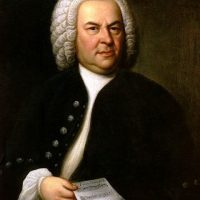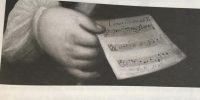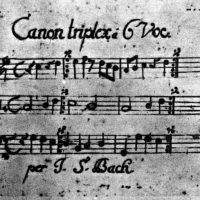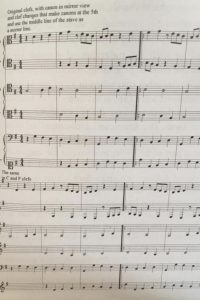SOME THOUGHTS ON BACH
Martin Luther wrote that “Music is a conspicuous gift of God and next in importance to Theology. Youth should be taught this Art for it makes fine, skilful people.” Well, Luther was ahead of his times, since today it is generally accepted that children who learn music from an early age develop their coordination and memory faster than their peers!
However, most people today do not see sacred music as an integral part of religious observance, but something heard in concerts or recordings. But in creating his opera Johann Sebastian Bach, coming from a long dynasty of musicians in Thuringia, proved to be a Lutheran through and through. For him music -whether vocal or instrumental- was a way of glorifying God. Hence his acceptance of the post of Cantor of St Thomas in Leipzig and the two cycles of cantatas he wrote there in celebration of the Christian calendar. Many of Luther’s own chorales, composed to be sung at Lutheran services, are found at the heart of Bach’s work, not just in the Cantatas and Passions, but cited in the instrumental works. Many musicologists point out that in his more developed later works Bach became more abstract and “mathematical”.
As Adrian Pinzaru tells us in his interview, the composer used the notes in the last and incompleted part of the Art of Fugue (Fuga a 3 soggetti) B-A-C-H (B flat, A, C and B) as a kind of musical signature or monogram. It was used by Bach in many of his earlier works, as for instance in the B minor mass, the Goldberg Variations, often hidden inconspicuously. In translating notes into numbers, the A B C of our alphabet become 1,2,3 and so on. The composer’s surname thus adds up to the number 14 (: A-1, B- 2, C-3, H -8), a number which became symbolically important for Bach. Works that had particular significance for him often had 14 movements, such as his 2 debut cantatas BWV wv75 & 76, the opening of his Leipzig cantata series. (The Lutheran year stated after on the First Sunday after Trinity in May/June). But the most extraordinary example is the BWV 1087, 14 Canons on the Goldberg ground, which were only rediscovered in 1974 in an old volume- nothing less than Bach’s personal copy of the GOLDBERG VARIATIONS, where at the back were found the additional 14 Canons .
The 13th of these is the famous Triplex Canon which is written out on the sheet of manuscript paper held by Bach in Haussman’s Portrait (the second of 1748), which the composer commissioned so as to be qualified to enter Lorenz Mizler’s Society, whose aim was to make theoretical musical treatises available through correspondence. (Other illustrious composers who belonged to the Society were Handel and Telemann.) Bach, however preferred to send something more tangible than a written theoretical work. He chose these 14 Canons, an amazing technical achievement. Here in the portrait he is seen holding a sheet of manuscript paper on which the 3 pentagrams make up the TRIPLEX CANON a 6 voci, the 13th of the 14 canons. The manuscript looks so simple- how is one to read it? Here is the trick: it must be read i) as viewed by the observer, ii) as seen by Bach looking down, and iii) from where he has made a sign indicating to start the canon a bar later- all this to be reversed, turned upside down and with the various different clefs in place.




BACH was unbelievably industrious and wrote so many works, often at great speed. It’s nice to know he sometimes re-used an idea. Here is an example in the opening Sinfonia of Cantatas BWV 29 (Wir Danken dir, Gott) which is based on a famous instrumental work. As string players we should know the original work in question- So what is it? Does it sound better now with a full Bach –size orchestra?
J. S. Bach, Cantata BWV 29 Wir danken dir, Gott
E. W.
J. S. Bach, The Art of the Fugue
Interview with Adrian Pinzaru, Delian::Quartett

- What is Bach’s ART OF THE FUGUE?
Bach’s Art of the Fugue is one of the pillars of Western culture, on the scale of works such as Goethe’s Faust, Dante Alighieri’s Divine Comedy, James Joyce’s Ulysses or The Flagellation of Christ by Piero della Francesca. In my opinion this work attains perfection. It contains all possible levels of interpretation and explanation: poetic, philosophical, religious. This work is pure abstractions but at the same time launches into sublime poetical moments. The Art of the Fugue also constitutes a great paradox: as it is composed of fugues and canons it is relatively simple to analyse. However, the more you get involved on this intellectual process, the more distant you feel yourself become from the work’s deepest meaning. As I said, this work attains perfection: to try to define it is like attempting to define God, impossible unless you use God’s own words. The Art of the Fugue IS Music and can therefore only be defined by the notes it is composed of, which make up its body and its spirit.
That is what Bach’s Art of the Fugue is.
- What advice would you give a listener who approaches the Art of the Fugue for the first time?
This work must be one of the most studied in the history of music so I do not feel I can add any more to the analysis of great artists and musiologists. I would like to give just one small piece of advice which is what we wrote in the booklet of our Art of the Fugue CD. Our advice to the listener is not to tackle the Art of the Fugue as an entire work, but to interspers their daily activity with a fugue or two. It’s a little like keeping a box of chocolates in the cupboard: every so often we reach into the box, experience a few instants of pleasure and then continue with our normal lives. The Art of the Fugue is not a work to be enjoyed ‘in one go’. Not that it does not have a strong structure, but its contrapunctal content is so concentrated that our minds are just not able to follow all the musical material in it. There comes a time when our attention wanders and our mind refuses to deal with such complexity any longer.
I think this is my best advice to the listener: go to the box and have a chocolate, from time to time.
- How did the Art of the Fugue repertoire and recording project take shape?
The Art of the Fugue project took shape and place very much like most of our recording projects. One of us comes up with an idea, in this case it was me: ‘Why don’t we learn some Canons and Fugues from Bach’s Art of the fugue? They’re very useful for intonation, coordination and sound. It’s also a fantastic piece of music!’.
And so we started learning this work in 2009, practising it and then performing it in concert. As we added counterpoint after counterpoint to our repertoire the idea of making a recording tarted to take shape. This long journey of research and hard work led us to develop an interpretation which, at a certain point, we felt we wanted to record permanently. In 2015 we said: ‘Let’s give ourselves a gift and record the entire work. In fact this recording is nothing but a great gift we gave ourselves.This may be a slightly selfish way of looking at the whole process but I know my colleagues agree with me when I say that I think we treated our egos to a maximum level of satisfaction.
And that is how we came to record The Art of the Fugue.
- Do you have any significant memories of your time studying and recording this work?
A masterpiece such as The Art of the Fugue always touches and influences you deeply. Many moments of our years spent studying this work have been memorable, but I am going to tell about one in particular connected to the recording of it.
After completing the recording I arrived in Düsseldorf, from where I was supposed to fly back home early the next morning, completely exhausted. It was 7.40 p.m. I lay in my hotel room in all-pervading tiredness with one thought buzzing in my brain: what will my next project be? I was asking myself this because I had the distinct feeling that afterthe Art of the Fugue there could be nothing but silence. Learning this work had, in a way, been a search for the very origins of creativity, a journey upstream to its gushing springs. At that moment I I felt I was a mere step away from revelation of a mystery. I had reached the last boundary, alas for me uncrossable, beyond which are true knoweldge and awareness, the ultime Truth. The Ultimate Truth was, however, enveloped in Silence, which was all I could see beyond that final boundary.
Naturally my life continued even after The Art of the Fugue but, coming back to day to day life, I was able to find many answers to that one Great Question.
RECOMMENDED LISTENING
J. S. Bach, The Art of the Fugue – Delian::Quartett
Recommended Reading
A. Schweitzer, J. S. Bach Vol. II, Dover, 1967
Donald Tovey, A companion to The Art of the Fugue, Oxford University Press 1931
John Eliot Gardiner, Music in the Castle of Heaven, Vintage, 2015
